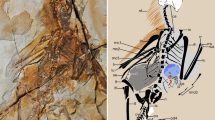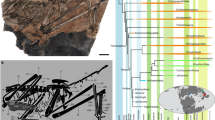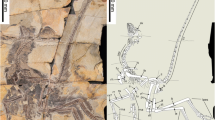Abstract
The fossil record of basal paravians in Gondwana is still poorly known, being limited to the Cretaceous unenlagiids from South America and the problematic Rahonavis from Madagascar. Here we report on a new paravian from the Cenomanian-Turonian (Late Cretaceous) of Río Negro province, NW Patagonia, Argentina. The new taxon exhibits a derived bird-like morphology of the forelimbs (e.g., robust ulna with prominent, anteriorly oriented, and proximally saddle-shaped radial cotyle and wide medial flange on metacarpal I) and a plesiomorphic foot with a raptorial pedal digit II. Phylogenetic analysis recovers the new taxon in a monophyletic clade with Rahonavis, being the sister group of the remaining Avialae and more derived than other non-avian dinosaurs. Both exhibit derived forelimb traits in opposition with their plesiomorphic hind limbs. The position of the new taxon and Rahonavis as stem avialans indicates that Gondwanan basal paravians are represented by two different clades, at least. The new taxon probably constitutes a previously unknown grade in the avian-line theropods in which some flight-related adaptations of the forelimbs are present in cursorial taxa. The present discovery sheds light on the acquisition of flight-related traits in non-avian dinosaurs and on the still poorly known paravian radiation in Gondwana.


Similar content being viewed by others
Data Availability
Not applicable.
References
Agnolin, F, Novas, FE (2013) Avian ancestors: a review of the phylogenetic relationships of the theropods Unenlagiidae, Microraptoria, Anchiornis and Scansoriopterygidae. Springer Science & Business Media.
Agnolin F, Motta MJ, Brissón Egli F, Lo Coco G, Novas FE (2019) Paravian phylogeny and the dinosaur-bird transition: an overview. Front Earth Sci 6:252. https://doi.org/10.3389/feart.2018.00252
Apesteguía S, Smith ND, Valieri RJ, Makovicky PJ (2016) An unusual new theropod with a didactyl manus from the Upper Cretaceous of Patagonia, Argentina. PLoS One 11(7):e0157793. https://doi.org/10.1371/journal.pone.0157793
Baiano M, Coria R, Cau A (2020) A new abelisauroid (Dinosauria: Theropoda) from the Huincul Formation (lower Upper Cretaceous, Neuquén Basin) of Patagonia, Argentina. Cretac Res 110:104408. https://doi.org/10.1016/j.cretres.2020.104408
Bakker RT, Kralis D, Siegwarth J, Filla J (1992) Edmarka rex, a new, gigantic theropod dinosaur from the middle Morrison Formation, Late Jurassic of the Como Bluff outcrop region. Hunteria 2(9):1–24
Baumel JJ (1993) Nomina anatomica avium. Academic Press.
Brissón Egli F, Aranciaga Rolando AM, Agnolín FL, Novas FE (2017) Osteology of the unenlagiid theropod Neuquenraptor argentinus from the Late Cretaceous of Patagonia. Acta Palaeontol Pol 62:549–562. https://doi.org/10.4202/app.00348.2017
Brusatte SL, Lloyd GT, Wang SC, Norell MA (2014) Gradual assembly of avian body plan culminated in rapid rates of evolution across the dinosaur-bird transition. Curr Biol 24(20):2386–2392. https://doi.org/10.1016/j.cub.2014.08.034
Burnham DA (2004) New information on Bambiraptor feinbergi from the Late Cretaceous of Montana. In: Currie PJ, Koppelhus EB, Shugar MA et al (eds) Feathered dragons: studies on the transition from dinosaurs to birds. Indiana University Press, Indianapolis, pp 67–111
Canale JI, Scanferla CA, Agnolin FL, Novas FE (2009) New carnivorous dinosaur from the Late Cretaceous of NW Patagonia and the evolution of abelisaurid theropods. Naturwissenschaften 96(3):409–414
Carpenter K (2002) Forelimb biomechanics of nonavian theropod dinosaurs in predation. Senckenb Lethaea 82(1):59–75
Cerroni MA, Motta MJ, Agnolín FL, Aranciaga Rolando AM, Brissón Egli F, Novas FE (2020) A new abelisaurid from the Huincul Formation (Cenomanian-Turonian; Upper Cretaceous) of Río Negro province, Argentina. J S Am Earth Sci 98:102445. https://doi.org/10.1016/j.jsames.2019.102445.
Chiappe LM, Meng, Q (2016). Birds of stone: Chinese avian fossils from the age of dinosaurs. JHU Press.
Coria RA, Currie PJ (2006) A new carcharodontosaurid (Dinosauria, Theropoda) from the Upper Cretaceous of Argentina. Geodiversitas 28(1):71–118
Coria RA, Salgado L (1998) A basal Abelisauria Novas, 1992 (Theropoda-Ceratosauria) from the Cretaceous of Patagonia, Argentina. Gaia 15:89–102
Forster CA, Sampson SD, Chiappe LM, Krause DW (1998) The theropod ancestry of birds: new evidence from the Late Cretaceous of Madagascar. Science 279(5358):1915–1919
Foth C, Rauhut OW (2017) Re-evaluation of the Haarlem Archaeopteryx and the radiation of maniraptoran theropod dinosaurs. BMC Evol Biol 17:236. https://doi.org/10.1186/s12862-017-1076-y
Garrido AC (2010) Estratigrafía del Grupo Neuquén, Cretácico Superior de la Cuenca Neuquina (Argentina): Nueva propuesta de ordenamiento litoestratigráfico: Revista del Museo Argentino de Ciencias Naturales, 12, p. 121–177
Gauthier J (1986) Saurischian monophyly and the origin of birds. Mem Calif Acad Sci 8:1–55
Gianechini FA, Makovicky PJ, Apesteguía S (2017) The cranial osteology of Buitreraptor gonzalezorum Makovicky, Apesteguía, and Agnolín, 2005 (Theropoda, Dromaeosauridae), from the Late Cretaceous of Patagonia, Argentina. J Vertebr Paleontol 37(1):e1255639. https://doi.org/10.1080/02724634.2017.1255639
Gianechini FA, Makovicky PJ, Apesteguía S, Cerda I (2018) Postcranial skeletal anatomy of the holotype and referred specimens of Buitreraptor gonzalezorum Makovicky, Apesteguía and Agnolín 2005 (Theropoda, Dromaeosauridae), from the Late Cretaceous of Patagonia. PeerJ 6:e4558. https://doi.org/10.7717/peerj.4558
Hu D, Clarke JA, Eliason CM, Qiu R, Li Q, Shawkey MD, D’Alba L, Jiang J, Xu X (2018) A bony-crested Jurassic dinosaur with evidence of iridescent plumage highlights complexity in early paravian evolution. Nat Commun 9(1):217. https://doi.org/10.1038/s41467-017-02515-y
Lefèvre U, Hu D, Escuillié F, Dyke G, Godefroit P (2014) A new long-tailed basal bird from the Lower Cretaceous of north-eastern China. Biol J Linn Soc 113(3):790–804. https://doi.org/10.1111/bij.12343
Makovicky PJ, Norell MA (2004) Troodontidae. In: Weishampel DB, Dodson P, Osmolska H (eds) The Dinosauria, 2nd edn. University of California Press, Berkeley, pp 196–209
Makovicky P, Apesteguía S, Agnolín FL (2005) The earliest dromaeosaurid theropod from South America. Nature 437:1007–1011
Motta MJ, Aranciaga Rolando AM, Rozadilla S, Agnolín FE, Chimento NR, Brissón Egli F, Novas FE (2016) New theropod fauna from the Upper Cretaceous (Huincul Formation) of northwestern Patagonia, Argentina. In Khosla, A. and Lucas, S.G., eds., 2018, Cretaceous period: biotic diversity and biogeography. New Mexico Museum of Natural History and Science Bulletin 71.
Motta MJ, Brissón Egli F, Novas FE (2018) Tail anatomy of Buitreraptor gonzalezorum (Theropoda, Unenlagiidae) and comparisons with other basal paravians. Cretac Res 83:168–181. https://doi.org/10.1016/j.cretres.2017.09.004
Norell MA, Makovicky PJ (1997) Important features of the dromaeosaur skeleton: information from a new specimen. Am Mus Novit 3215:1–28
Norell MA, Makovicky PJ (2004) Dromaeosauridae. In: Weishampel DB, Dodson P, Osmolska H (eds) The Dinosauria, 2nd edn. University of California Press, Berkeley, pp 196–209
Novas FE (2004) Avian traits in the ilium of Unenlagia comahuensis (Maniraptora, Avialae). In: Currie PJ, Koppelhus EB, Shugar MA et al (eds) Feathered dragons: studies on the transition from dinosaurs to birds. Indiana University Press, Indianapolis, pp 150–168
Novas FE, Pol D (2005) New evidence on deinonychosaurian dinosaurs from the Late Cretaceous of Patagonia. Nature 433:858–861
Novas FE, Puerta PF (1997) New evidence concerning avian origins from the Late Cretaceous of Patagonia. Nature 387:390–392
Novas FE, Pol D, Canale JI, Porfiri JD, Calvo JO (2008) A bizarre Cretaceous theropod dinosaur from Patagonia and the evolution of Gondwanan dromaeosaurids. Proc R Soc B 276(1659):1101–1107. https://doi.org/10.1098/rspb.2008.1554
Novas FE, Brissón Egli F, Agnolin FL, Gianechini FA, Cerda I (2018) Postcranial osteology of a new specimen of Buitreraptor gonzalezorum (Theropoda, Unenlagiidae). Cretac Res 83:127–167. https://doi.org/10.1016/j.cretres.2017.06.003
Ostrom JH (1969) Osteology of Deinonychus antirrhopus, an unusual theropod from the Lower Cretaceous of Montana (Vol. 30). Pea Mus Bull 30:1–165
Ostrom JH (1976) Archaeopteryx and the origin of birds. Biol J Linn Soc 8(2):91–182
Paul GS (2002) Dinosaurs of the air: the evolution and loss of flight in dinosaurs and birds. JHU Press, Baltimore
Pei R, Li Q, Meng Q, Norell MA, Gao KQ (2017) New specimens of Anchiornis huxleyi (Theropoda: Paraves) from the Late Jurassic of northeastern China. B Am Mus Nat Hist 411:1–67
Porfiri JD, Calvo JO, dos Santos D (2011) A new small deinonychosaur (Dinosauria: Theropoda) from the Late Cretaceous of Patagonia, Argentina. An Acad Bras Cienc 83(1):109–116. https://doi.org/10.1590/S0001-37652011000100007
Prieto-Márquez A, Bolortsetseg M, Horner JR (2012) A diminutive deinonychosaur (Dinosauria: Theropoda) from the Early Cretaceous of Öösh (Övörkhangai, Mongolia). Alcheringa 36(1):117–136
Rauhut OW, Werner C (1995) First record of the family Dromaeosauridae (Dinosauria: Theropoda) in the Cretaceous of Gondwana (Wadi Milk Formation, northern Sudan). Paläontol Z 69(3-4):475–489
Rauhut OW, Foth C, Tischlinger H (2018) The oldest Archaeopteryx (Theropoda: Avialiae): a new specimen from the Kimmeridgian/Tithonian boundary of Schamhaupten, Bavaria. PeerJ 6:e4191. https://doi.org/10.7717/peerj.4191
Rauhut OW, Tischlinger H, Foth C (2019) A non-archaeopterygid avialan theropod from the Late Jurassic of southern Germany. eLife 8:e43789. https://doi.org/10.7554/eLife.43789.001
Turner AH, Makovicky PJ, Norell MA (2012) A review of dromaeosaurid systematics and paravian phylogeny. B Am Mus Nat Hist 20:1–206. https://doi.org/10.1206/748.1
Vazquez RJ (1994) The automating skeletal and muscular mechanisms of the avian wing (Aves). Zoomorphology 114(1):59–71
Wellnhofer P (2009) Archaeopteryx: the icon of evolution. F. Pfeil, Munich
Xu X (2002) Deinonychosaurian fossils from the Jehol group of western Liaoning and the coelurosaurian evolution. Ph.D. thesis, Chinese Academy of Sciences, Beijing, 1–322.
Xu X, Zhang F (2005) A new maniraptoran dinosaur from China with long feathers on the metatarsus. Naturwissenschaften 92:173–177. https://doi.org/10.1007/s00114-004-0604-y
Xu X, Wang XL, Wu XC (1999) A dromaeosaurid dinosaur with a filamentous integument from the Yixian Formation of China. Nature 401:262–266. https://doi.org/10.1038/45769
Xu X, Zhao Q, Norell M, Sullivan C, Hone D, Erickson G, Wang X, Han F, Guo Y (2008) A new feathered maniraptoran dinosaur fossil that fills a morphological gap in avian origin. Chin Sci Bull 54:430–435. https://doi.org/10.1007/s11434-009-0009-6
Xu X, You H, Du K, Han F (2011) An Archaeopteryx-like theropod from China and the origin of Avialae. Nature 475:465–470. https://doi.org/10.1038/nature10288
Zhou Z, Zhang F (2003) Anatomy of the primitive bird Sapeornis chaoyangensis from the Early Cretaceous of Liaoning, China. Can J Earth Sci 40:731–747. https://doi.org/10.1139/e03-011
Acknowledgments
We thank X. Xu and M. Pittman for their useful comments and observations about the morphology of Overoraptor. We thank M. Isasi, A. M. Aranciaga Rolando, S. Rozadilla, J. A. García Marsà, A. R. Gentil, J. S. D’Angelo, M. Cerroni, G. Álvarez Herrera, G. Muñoz, G. Lio, G. Lo Coco, A. Moreno and A. Martinelli for their comments on present contribution and their invaluable help during the fieldwork. M.D. Ezcurra helped with the phylogenetic analyses. Special thanks to the Violante family, Silverio Manfio (Ingeniería SIMA S.A.), Joaquín Mendoza, and P. Chafrat for their logistic support during the expedition. Secretaría de Cultura de la Provincia de Río Negro is acknowledged for their support during the fieldwork. We thank the technicians M. Isasi, C. H. Alsina, and N. Olejnik for the technical preparation of the specimen described here. Special thanks to an anonymous reviewer and Corwin Sullivan for their enlightening comments on the manuscript. Finally, we thank Editor A. Grandal-d’Anglade for her help during the editorial process of the manuscript.
Funding
This research was supported by the National Geographic Society (CP-096ER-17), and Mr. Coleman Burke (New York).
Author information
Authors and Affiliations
Contributions
All authors listed have made a substantial, direct, and intellectual contribution to the work and approved it for publication.
Corresponding author
Ethics declarations
Conflict of interest
The authors declare that they have no conflict of interest.
Ethical approval
This article does not contain any studies with human participants or animals performed by any of the authors.
Code availability
Not applicable.
Additional information
Communicated by: Aurora Grandal-d’Anglade
Publisher’s note
Springer Nature remains neutral with regard to jurisdictional claims in published maps and institutional affiliations.
Electronic supplementary material
ESM 1
(DOCX 873 kb)
Rights and permissions
About this article
Cite this article
Motta, M.J., Agnolín, F., Brissón Egli, F. et al. New theropod dinosaur from the Upper Cretaceous of Patagonia sheds light on the paravian radiation in Gondwana. Sci Nat 107, 24 (2020). https://doi.org/10.1007/s00114-020-01682-1
Received:
Revised:
Accepted:
Published:
DOI: https://doi.org/10.1007/s00114-020-01682-1




